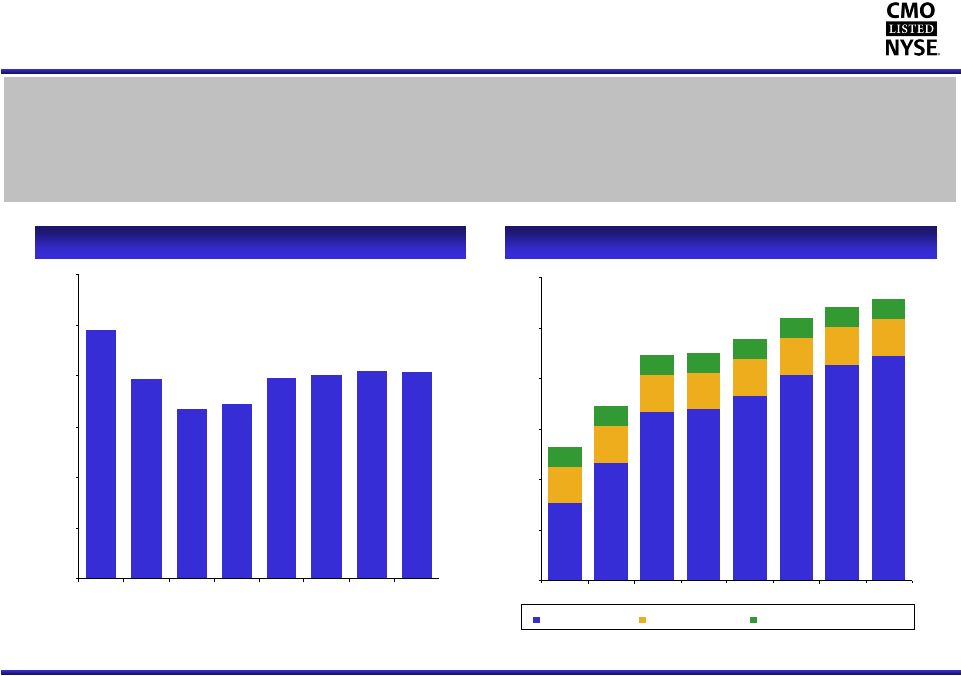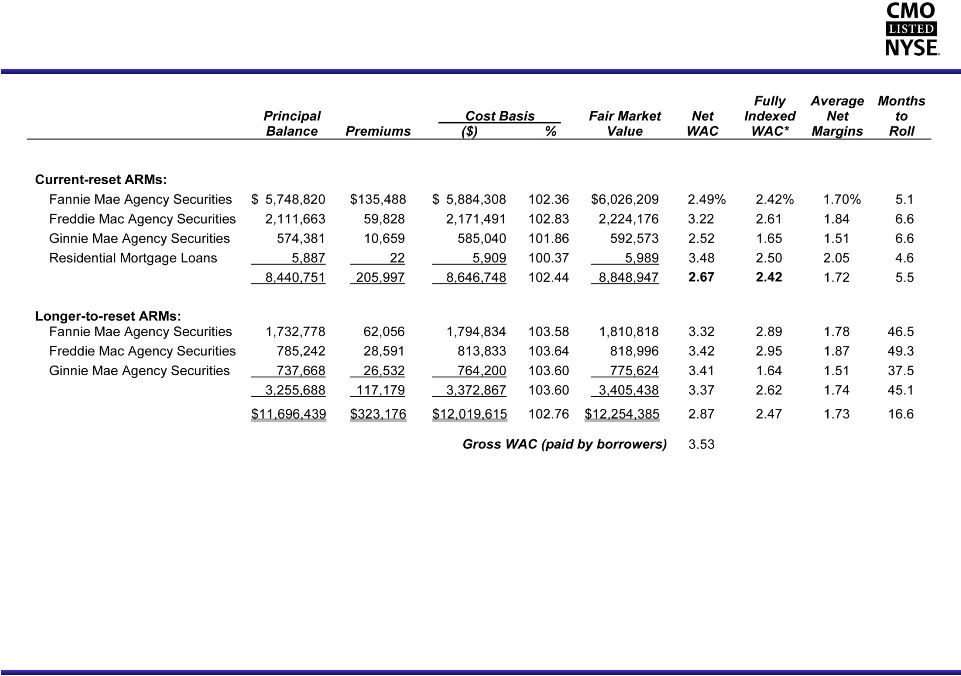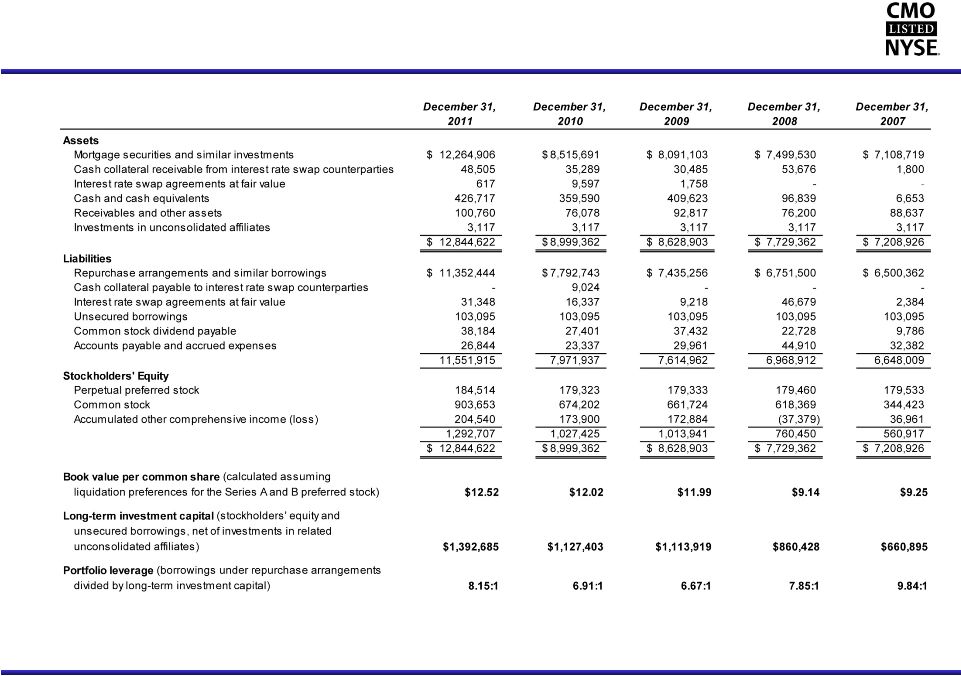Attached files
| file | filename |
|---|---|
| 8-K - FORM 8-K - CAPSTEAD MORTGAGE CORP | d326811d8k.htm |
 CAPSTEAD
Information as of December 31, 2011
Investor Presentation
Exhibit 99.1 |
 Safe
Harbor Statement - Private Securities Litigation Reform Act of 1995
Cautionary Statement Concerning Forward-looking Statements
This
document
contains
“forward-looking
statements”
within
the
meaning
of
the
Private
Securities
Litigation
Reform
Act
of
1995.
Forward-looking
statements
include,
without
limitation,
any
statement
that
may
predict,
forecast,
indicate
or
imply
future
results,
performance
or
achievements,
and
may
contain
the
words
“believe,”
“anticipate,”
“expect,”
“estimate,”
“intend,”
“will
be,”
“will
likely
continue,”
“will
likely
result,”
or
words
or
phrases
of
similar
meaning.
Forward-looking
statements
are
based
largely
on
the
expectations
of
management
and
are
subject
to
a
number
of
risks
and
uncertainties
including,
but
not
limited
to,
the
following:
In
addition
to
the
above
considerations,
actual
results
and
liquidity
are
affected
by
other
risks
and
uncertainties
which
could
cause
actual
results
to
be
significantly
different
from
those
expressed
or
implied
by
any
forward-looking
statements
included
herein.
It
is
not
possible
to
identify
all
of
the
risks,
uncertainties
and
other
factors
that
may
affect
future
results.
In
light
of
these
risks
and
uncertainties,
the
forward-looking
events
and
circumstances
discussed
herein
may
not
occur
and
actual
results
could
differ
materially
from
those
anticipated
or
implied
in
the
forward-looking
statements.
Forward-looking
statements
speak
only
as
of
the
date
the
statement
is
made
and
the
Company
undertakes
no
obligation
to
update
or
revise
any
forward-looking
statements,
whether
as
a
result
of
new
information,
future
events
or
otherwise.
Accordingly,
readers
of
this
document
are
cautioned
not
to
place
undue
reliance
on
any
forward-looking
statements included herein.
–
changes in general economic conditions;
–
fluctuations in interest rates and levels of mortgage
prepayments;
–
the effectiveness of risk management strategies;
–
the impact of differing levels of leverage employed;
–
liquidity of secondary markets and credit markets;
–
the availability of financing at reasonable levels and terms to
support investing on a leveraged basis;
–
the availability of new investment capital;
–
the availability of suitable qualifying investments from both
an investment return and regulatory perspective;
–
changes in legislation or regulation affecting exemptions for
mortgage REITs from regulation under the Investment
Company Act of 1940;
–
changes in legislation or regulation affecting Fannie Mae and
Freddie Mac (together, the “GSEs”) and similar federal
government agencies and related guarantees;
–
deterioration in credit quality and ratings of existing or future
issuances of GSE or Ginnie Mae Securities; and
–
increases in costs and other general competitive factors.
2 |
 Company Summary
Proven Strategy
Experienced
Management Team
Aligned with
Stockholders
Overview of Capstead Mortgage Corporation
•
Founded in 1985, Capstead is the oldest publicly-traded Agency mortgage
REIT. •
At December 31, 2011, we had a total investment portfolio of $12.26 billion,
supported by long- term investment capital of $1.39 billion levered 8.15
times.* •
Our five-year compound annual total return of 23.2%.**
•
We invest exclusively in residential adjustable-rate mortgage (ARM) securities
issued and guaranteed by Fannie Mae, Freddie Mac or Ginnie Mae.
Agency-guaranteed mortgage securities are considered to have little, if
any, credit risk. •
Our focus on short-duration ARM securities augmented with interest rate swap
agreements differentiates
us
from
our
peers
because
ARM
securities
reset
to
more
current
interest
rates
within
a
relatively
short
period
of
time.
This
allows
for
the
recovery
of
financing
spreads
diminished
during
periods
of
rising
interest
rates
and
smaller
fluctuations
in
portfolio
values
from
changes
in
interest rates compared to fixed-rate mortgage securities. With this
strategy, Capstead is recognized as the most
defensively-positioned Agency mortgage REIT from an interest rate risk
perspective.
•
Our prudently leveraged portfolio provides financial flexibility
to manage changing market
conditions.
•
Our executive officers have over 80 years of combined mortgage finance industry
experience, including 75 years at Capstead.
•
We are self-managed with low operating costs and a focus on
performance-based compensation
for
our
executive
officers.
This
structure
greatly
enhances
the
alignment
of
management interests with those of our stockholders.
3
* Long-term
investment
capital
includes
stockholders’
equity
and
unsecured
borrowings,
net
of
investments
in
related
unconsolidated
affiliates.
** Compound annual growth rate is based on cumulative total returns assuming
an investment in Capstead was made December 31, 2006 and dividends were reinvested. |
 Market
Snapshot (dollars in thousands, except per share amounts)
Perpetual Preferred
Trust
Total Long-Term
Common
Series A
Series B
Preferred
Investment Capital
NYSE Stock Ticker
CMO
CMOPRA
CMOPRB
Shares outstanding
(a)
88,287
186
16,184
Cost of preferred capital
(a)
11.44%
11.21%
8.49%
10.26%
Price as of March 30, 2012
$13.11
$23.38
$14.58
Book Value per common share
(a)
$12.52
Price as a multiple of December 31, 2011
book value
104.7%
Recorded value
(a)
$1,108,193
$2,605
$181,909
$99,978
$1,392,685
Market capitalization as of March 30, 2012
(b)
$1,157,443
$4,349
$235,963
$99,978
$1,497,733
(a)
As of December 31, 2011.
(b)
Includes common and preferred shares issued subsequent to year-end. During the first quarter
of 2012 we raised an additional $60.0 million in new common equity capital and $3.3 million in
new Series B preferred equity capital through the issuance of 4.6 million common shares and 231k Series B preferred shares,
respectively, under our at-the market continuous offering program.
4
We
declared
a
$0.43
per
common
share
first
quarter
2012
dividend
payable
to
stockholders
of
record
on
March 30, 2012 (March 28 ex-dividend date). Common dividends declared in
2011 totaled $1.76. |
 Capstead’s Prudent Use of Leverage
5
**
Borrowings under repurchase arrangements divided by long-term investment
capital. Portfolio leverage ended 2011 at 8.15 to one. In our view,
borrowing at current levels represents an appropriate and prudent use of
leverage for an agency-guaranteed ARM securities portfolio in today’s market conditions.
During 2011 we raised $232 million in new common equity capital and $5 million in
Series B preferred equity capital using our
at-the-market
continuous
offering
program.
During
the
first
quarter
of
2012,
we
raised
an
additional
$60
million
in common
and
$3
million
in
Series
B
preferred
equity
capital
under
the
program.
($ in millions)
Portfolio Leverage*
Long-Term Investment Capital
$661
$860
$1,114
$1,127
$1,194
$1,297
$1,351
$1,393
80%
79%
78%
77%
75%
75%
67%
58%
13%
14%
15%
16%
16%
21%
27%
13%
7%
8%
8%
15%
12%
9%
9%
8%
$
$250
$500
$750
$1,000
$1,250
$1,500
12/31/07
12/31/08
12/31/09
12/31/10
3/31/11
6/30/11
9/30/11
12/31/11
Common Stock
Preferred Stock
Trust Prefered Securities, net
9.84x
7.85x
6.67x
6.91x
7.91x
8.05x
8.21x
8.15x
0.0x
2.0x
4.0x
6.0x
8.0x
10.0x
12.0x
12/31/07
12/31/08
12/31/09
12/31/10
3/31/11
6/30/11
9/30/11
12/31/11
$100
$185
$1,108
Common Stock
Preferred Stock
Trust Preferred Securities, net |
 34%
66%
28%
72%
Capstead’s Proven Short-Duration Investment Strategy
6
As of December 31, 2011
As of December 31, 2011
Low
risk
agency-guaranteed
residential
ARM
securities
financed
primarily
with
30-90
day
“repo”
borrowings,
augmented with two-year interest rate swap agreements for hedging
purposes. Residential ARM Securities Portfolio
Repurchase Arrangements & Similar Borrowings
Total: $11.35
billion
* Based on fair market value as of the indicated balance sheet
date. Total: $12.26 billion*
•
Most of our securities are backed by well-seasoned mortgage
loans with coupon interest rates that reset at least annually or
begin doing so after an initial fixed-rate period of five years or
less.
•
We have long-term relationships with numerous lending
counterparties. As of December 31, 2011, we had borrowings
outstanding with 24 counterparties.
•
Fourth quarter borrowing rates remained at favorable levels.
Average repo borrowing rates ended the quarter at 0.36%
(0.58% including related interest rate swaps).
•
At December 31, 2011 we held $3.9 billion notional amount of
currently-paying
two-year
interest
rate
swaps
requiring
fixed
rate payments averaging 0.90% with average maturities of 13
months, $800 million of which with rates averaging 1.10%
matured during the first quarter of 2012. An additional $600
million notional amount of two-year swaps were held at year-
end that require fixed rate payments averaging 0.54% for two-
year periods that commence on various dates between January
2012 and April 2012.
•
The duration of our investment portfolio and related ‘repo’
borrowings
was
approximately
9¾
months
and
6
months,
respectively, at December 31, 2011. This resulted in a net
duration
gap
of
approximately
3¾
months.
Duration
is
a
measure of market price sensitivity to interest rate movements.
Longer-to-Reset
ARMs
$3.41 Billion
Current-Reset
ARMs
$8.85 Billion
Borrowings Hedged with
Currently-Paying
Interest Rate Swaps
$3.90 Billion
Unhedged
Borrowings
$7.45
Billion |
 Capstead’s Stockholder Friendly Structure
7
3 mos. ended
Year ended
Dec. 31, 2011
Dec. 31, 2011
Compensation-related expenses:
Fixed:
Salaries and related deferred compensation match,
payroll taxes, insurance and other benefits
0.28%
0.26%
Variable:
Incentive Compensation
**
0.44
0.45
71%
and 72% of compensation-related
Dividend Equivalent Rights
0.07
0.07
expenses for the year and three
Performance Stock Awards
0.12
0.11
months ended December 31, 2011,
Related deferred compensation match and payroll taxes
0.05
0.05
respectively, were performance-based
0.68
0.68
0.96
0.94
Other platform expenses
0.31
0.29
1.27%
1.23%
*
Expressed as a percentage of average long-term investment capital (LTIC).
**
Incentive compensation is based on a 10% participation in returns on LTIC in excess
of benchmark returns (greater of 10% or the average 10-year Treasury rate
plus 2.0%), capped at 50 basis points of LTIC and subject to Compensation Committee
discretion. •
Self-managed with low operating costs.
•
Our
board
of
directors
requires
management
to
hold
a
significant
amount
of
CMO
stock
based
on
a
multiple
of
each
executive’s
base
salary.
Our
most
recent
proxy
statement
discloses
that
as
of
February
22,
2012
our
directors
and
executive
officers
beneficially
owned
1.9%
of
our
common
shares.
•
Pay structure is variable through compensation elements that focus on “pay for
performance.” •
Management is incented to grow the Company by issuing common equity capital when it
is accretive to book
value
and
earnings,
rather
than
to
increase
compensation
or
external
management
fees.
•
Bottom line: our management prospers when our stockholders prosper.
|
 Capstead’s Asset Yields and Borrowing Costs
(dollars in thousands, unaudited)
8
* Includes yield adjustments for investment premium amortization of 63
and 66 basis points, respectively. ** See pages 15 and 16 for
discussion of use of financing spread on mortgage assets, a non-GAAP financial measure. |
 *
Fully
indexed
net
weighted
average
coupon,
or
WAC,
represents
the
coupon
upon
one
or
more
resets
using
interest
rates
indices
as
of
December
31,
2011
and
the
applicable
net
margin. NOTE: Excludes $10 million of fixed-rate investments.
Key Elements of Capstead’s ARM Portfolio
As of December 31, 2011 (dollars in thousands, unaudited)
9 |
 *
*
*
*
**
CAPSTEAD
Appendix
CAPSTEAD
10 |
 Capstead’s Fourth Quarter 2011 Highlights
•
Earnings of $42.0 million or $0.43 per diluted common share.
•
Our financing spread on mortgage assets* averaged 1.46%, reflecting lower ARM loan
coupon interest rate resets and marginally higher mortgage prepayments.
•
Our book value increased $0.02 to $12.52 per common share.
•
We raised $39 million in new equity capital using our at-the-market
continuous offering program contributing $0.01 to the increase in book value
per common share. •
Our
investment
portfolio
increased
$25
million
to
$12.26
billion
and
our
portfolio
leverage
decreased
modestly
to
8.15
times
our
long-term
investment capital.
•
Operating expense as a percentage of long-term investment capital averaged
1.23%. •
Comments from our February 1, 2012 earnings press release:
“Market
conditions
remain
favorable
for
investing
in
agency-guaranteed
residential
ARM
securities
on
a
leveraged
basis,
with
attractive
risk-
adjusted returns achievable in a financing environment that has remained relatively
stable despite European sovereign debt concerns and the failure of
MF
Global,
a
lending
counterparty
to
many
in
the
mortgage
REIT
sector.
During
the
fourth
quarter
we
grew
our
portfolio
modestly
to
$12.3
billion
while deploying $39
million in new common and preferred equity capital raised under our continuous
offering program. Portfolio leverage declined slightly to 8.15 times
our long-term investment capital, which in our view, represents an appropriate and prudent use of leverage for an agency-
guaranteed mortgage securities portfolio in today’s market conditions,
particularly for a portfolio consisting predominantly of current-reset ARM
securities.
“Mortgage prepayments continue to be a positive differentiating factor for
Capstead, declining to an annualized CPR of 15.6% during the fourth quarter
from 16.9% experienced during the previous quarter. This reflects factors we have previously articulated, namely, prepayments on more
seasoned securities continue to be suppressed by low housing prices and credit
problems being experienced by many of these borrowers, while prepayments on
newer originations remain somewhat elevated as a result of relatively low prevailing mortgage interest rates.
“The fundamental difference The fundamental difference between our investment
portfolio and those of our peers is our focus on investing solely in ARM
securities. At quarter-end these securities were backed by mortgages requiring borrowers to make payments predicated on rates averaging
a relatively low 3.53%. Additionally, 72% of our portfolio was invested in ARM
securities backed by mortgage loans that will reset in rate in less than
eighteen months, typically to a lower interest rate in today’s
environment. As a result, most borrowers with mortgage loans underlying securities in
our portfolio lack the ability to meaningfully lower their mortgage payments even
if they can overcome the other impediments to refinancing mentioned above.
For these reasons, we expect prepays to remain largely in check in 2012.
“The Federal Open Market Committee’s recently announced that economic
conditions “are likely to warrant exceptionally low levels for the
federal funds rate at least through late 2014.”
If this proves to be the case, we anticipate portfolio yields on our
current-reset ARM securities will trend modestly lower as coupon
interest rates on the underlying mortgage loans continue resetting to more current rates while our borrowing rates,
which declined in January 2012 from higher levels experienced late in the fourth
quarter of 2011, will remain relatively low with declining hedging costs
providing some offset to lower portfolio yields.” 11
* See
pages
15
and
16
for
discussion
of
use
of
financing
spread
on
mortgage
assets,
a
non-GAAP
financial
measure. |
 Capstead’s 2011 Operating Results
(dollars in thousands, except per share amounts) (unaudited)
12
Year Ended
December
December
September
June
March
2011
2011
2011
2011
2011
Interest income:
Mortgage securities and similar investments
243,077
$
63,910
$
62,890
$
63,136
$
53,141
$
Other
301
71
59
58
113
243,378
63,981
62,949
63,194
53,254
Interest expense:
Repurchase arrangements and similar borrowings
(57,328)
(15,556)
(15,744)
(13,706)
(12,322)
Unsecured borrowings
(8,747)
(2,187)
(2,186)
(2,187)
(2,187)
Other
(5)
-
-
(1)
(4)
(66,080)
(17,743)
(17,930)
(15,894)
(14,513)
177,298
46,238
45,019
47,300
38,741
Other revenue (expense):
Miscellaneous other revenue (expense)
(1,023)
(97)
(109)
(599)
(218)
Incentive compensation
(5,697)
(1,548)
(1,429)
(1,487)
(1,233)
Salaries and benefits
(6,701)
(1,698)
(1,631)
(1,672)
(1,700)
Other general and administrative expense
(3,932)
(992)
(911)
(1,066)
(963)
(17,353)
(4,335)
(4,080)
(4,824)
(4,114)
Income before equity in earnings of unconsolidated affiliates
159,945
41,903
40,939
42,476
34,627
Equity in earnings of unconsolidated affiliates
259
65
64
65
65
Net income
160,204
$
41,968
$
41,003
$
42,541
$
34,692
$
Net income per diluted common share
$1.75
$0.43
$0.43
$0.48
$0.41
Average long-term investment capital
1,284,057
$
1,370,471
$
1,350,693
$
1,253,747
$
1,158,254
$
Average balance of mortgage assets
10,839,749
12,111,091
11,609,545
10,601,719
8,993,926
Investment premium amortization
68,077
20,054
19,672
15,519
12,832
Portfolio runoff *
Average financing spread on mortgage assets**
1.83
1.68
18.6%
1.57
18.0%
17.1% Quarter Ended
1.77
19.9
1.60
19.3% * Represents total runoff
(scheduled payments and prepayments). The constant prepayment rate, or CPR, represents only prepayments and will typically be 150 to 250
basis points lower than the total runoff rate during any given period.
** See pages 15 and 16 for discussion of use of financing spread on
mortgage assets, a non-GAAP financial measure. %
|
 Capstead’s Operating Results -
Five Years Ended 2011
(dollars in thousands, except per share amounts) (unaudited)
13
December
December
December
December
December
2011
2010
2009
2008
2007
Interest income:
Mortgage securities and similar investments
243,077
$
199,300
$
314,100
$
398,285
$
310,698
$
Other
301
478
495
2,204
945
243,378
199,778
314,595
400,489
311,643
Interest expense:
Repurchase arrangements and similar borrowings
(57,328)
(47,502)
(120,083)
(249,706)
(266,901)
Unsecured borrowings
(8,747)
(8,747)
(8,747)
(8,747)
(8,747)
Other
(5)
(2)
-
-
-
(66,080)
(56,251)
(128,830)
(258,453)
(275,648)
177,298
143,527
185,765
142,036
35,995
Other revenue (expense):
Miscellaneous other revenue (expense)
(1,023)
(904)
(40,641)
(1,593)
(6,394)
Incentive compensation
(5,697)
(5,055)
(4,769)
(6,000)
-
Salaries
and benefits (6,701)
(6,097)
(5,655)
(4,978)
(3,423)
Other general and administrative expense
(3,932)
(4,834)
(5,696)
(3,801)
(3,248)
(17,353)
(16,890)
(56,761)
(16,372)
(13,065)
Income before equity in earnings of unconsolidated affiliates
159,945
126,637
129,004
125,664
22,930
Equity in earnings of unconsolidated affiliates
259
259
259
259
1,783
Net income
160,204
$
126,896
$
129,263
$
125,923
$
24,713
$
Net income per diluted common share
$1.75
$1.52
$1.66
$1.93
$0.19
Average long-term investment capital
1,284,057
$
1,120,647
$
1,032,853
$
813,428
$
483,703
$
Average balance of mortgage assets
10,839,749
7,665,796
7,604,530
7,630,958
5,510,503
Investment premium amortization
68,077
57,634
29,426
29,336
24,091
Portfolio runoff *
Average financing spread on mortgage assets**
18.6%
1.94
31.2% Year Ended
18.4%
0.52
28.1%
2.40
18.3%
1.69
1.68 * Represents total runoff
(scheduled payments and prepayments). The constant prepayment rate, or CPR, represents only prepayments and will typically be 150 to 250
basis points lower than the total runoff rate during any given period.
** See pages 15 and 16 for discussion of use of financing spread on
mortgage assets, a non-GAAP financial measure. |
 Capstead’s Comparative Balance Sheets
(dollars in thousands, except per share amounts)
14 |
 Capstead’s Use of Financing Spread on Mortgage
Assets, a Non-GAAP Financial Measure
Fourth Quarter 2011 (dollars in thousands, unaudited)
15 |
 Capstead’s Use of Financing Spread on Mortgage
Assets, a Non-GAAP Financial Measure
Year-Ended 2011 (dollars in thousands, unaudited)
16 |
 Experienced Management Team
17
Over 80 years of combined mortgage finance industry experience, including 75 years
at Capstead. Andrew
F.
Jacobs
–
President
and
Chief
Executive
Officer,
Director
–
Has served as president and chief executive officer since 2003 and has held various
executive positions at Capstead since 1988 –
Certified Public Accountant (“CPA”), member of the Board of Governors of
the National Association of Real Estate Investment Trusts
(“NAREIT”), chairman of NAREIT’s Council of Mortgage REITs, member
of the executive committee of the Chancellors Council of the University of
Texas System, the Executive Council of the Real Estate Finance and Investment Center at the University of Texas
at Austin, the American Institute of Certified Public Accountants
(“AICPA”), and the Financial Executive International (“FEI”)
Phillip
A.
Reinsch
–
Executive
Vice
President
and
Chief
Financial
Officer,
Secretary
–
Has
held
various
financial
accounting
and
reporting
positions
at
Capstead
since
1993
–
Formerly employed by Ernst & Young LLP as an audit senior manager focusing on
mortgage banking and asset securitization –
CPA, Member AICPA, FEI
Robert
A.
Spears
–
Executive
Vice
President,
Director
of
Residential
Mortgage
Investments
–
Has served in asset and liability management positions at Capstead since 1994
–
Formerly Vice President of secondary marketing with NationsBanc Mortgage
Corporation Michael
W.
Brown
–
Senior
Vice
President,
Asset
and
Liability
Management,
Treasurer
–
Has served in asset and liability management positions at Capstead since 1994
–
MBA, Southern Methodist University, Dallas, Texas |
